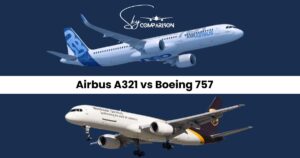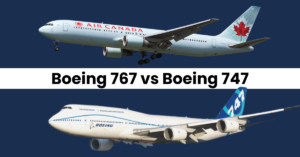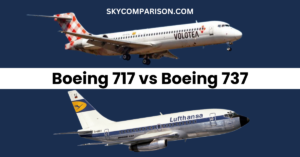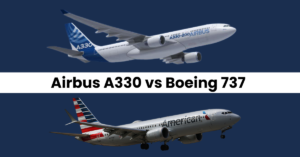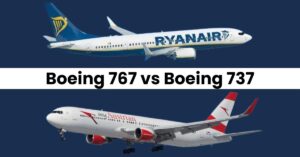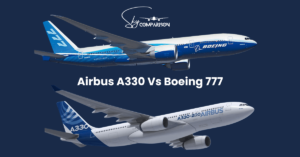Boeing 767 vs 777 | Comparison | Size & Passenger Capacity
Let’s take off on an adventure high above the clouds with two amazing planes: the Boeing 767 vs 777. Picture this: you’re stepping onto a plane, and every little thing, from the engine’s roar to the spot for your bag, tells a story of clever design and exciting journeys. The Boeing 767 is known for making faraway places feel closer, flying smoothly and saving fuel. The bigger Boeing 777 can take even more people to far-off lands, making it perfect for the longest trips. As we dive into this story, we’ll discover what makes these planes special and how they bring people around the world closer together.
Boeing 767 vs Boeing 777
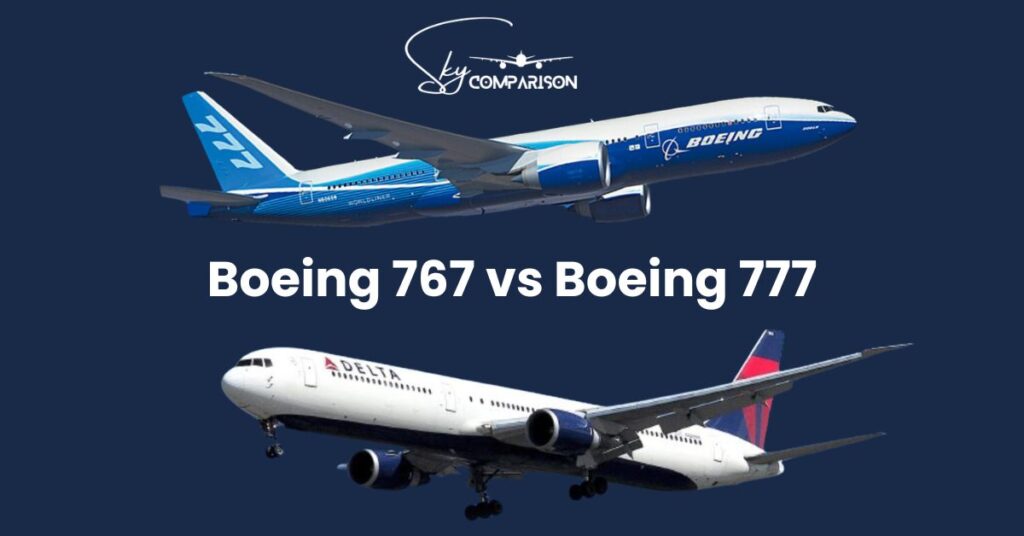
When you look at the Boeing 767 vs 777 side by side, the 777 is usually the bigger one, with more room inside for passengers and luggage. But things get interesting when you compare the biggest version of the 767, called the 767-400, with the smallest 777, known as the 777-200. The size difference between them isn’t as big as you might think. The 767-400 is only about eight feet shorter and its tail is about six feet lower than the 777-200’s. This shows that even though the 767 is generally smaller, its largest model comes pretty close in size to the 777, making it a strong choice for airlines that need a plane that’s big but not too big.
| Aircraft Model | Type | First In Service | Range |
|---|---|---|---|
| Boeing 767-200 | Passenger | 1982 | 3,850 |
| Boeing 767-200ER | Passenger | 1984 | 6,590 |
| Boeing 767-300 | Passenger | 1986 | 3,900 |
| Boeing 767-300ER | Passenger | 1988 | 5,980 |
| Boeing 767-400ER | Passenger | 2000 | 5,625 |
| Boeing 767-300F | Freighter | 1995 | 3,255 |
| Boeing 777-200 | Passenger | 1995 | 5,240 |
| Boeing 777-200ER | Passenger | 1997 | 7,065 |
| Boeing 777-200LR | Passenger | 2006 | 8,555 |
| Boeing 777-300 | Passenger | 1998 | 6,015 |
| Boeing 777-300ER | Passenger | 2004 | 7,370 |
| Boeing 777F | Freighter | 2009 | 4,970 |
| Boeing 777-8 | Passenger | – | 8,730 est. |
| Boeing 777-8F | Freighter | 2027 est. | – |
| Boeing 777-9 | Passenger | 2025 est. | 7,285 est. |
The Boeing 767 vs 777 families have made significant contributions to the aviation industry, with the 767 serving as a versatile and efficient option for various operations, and the 777 setting new standards in passenger comfort, range, and efficiency.
Boeing 767
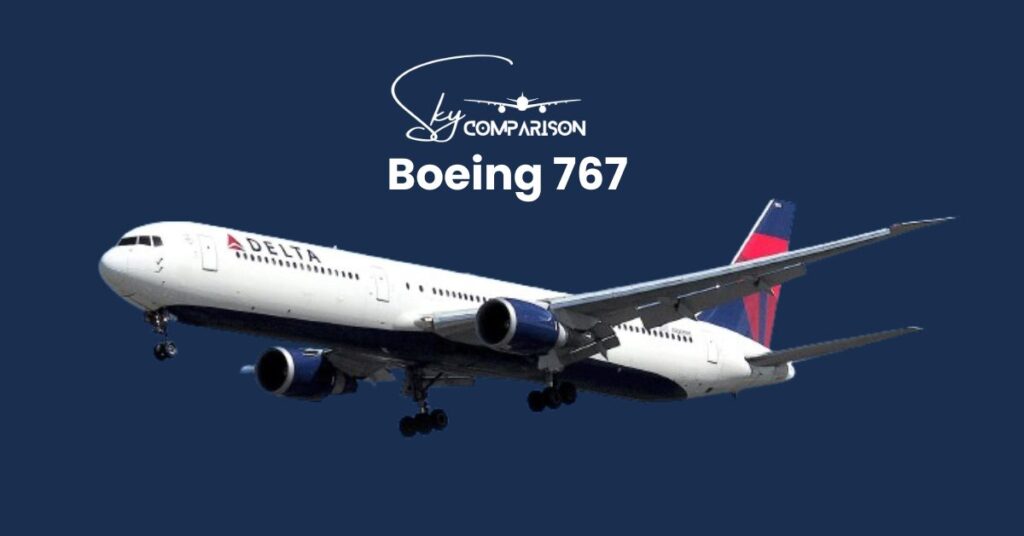
The Boeing 767 is a big airplane made by the company called Boeing, and it has been flying in the sky since the 1980s. It’s special because it can fly really long distances without stopping, which makes it great for trips that go over oceans or between far-away cities. The 767 is known for having two engines, which helps it use less fuel compared to planes with more engines, making it a smarter choice for airlines that want to save money and be kinder to the environment. Inside, it’s comfortable for passengers, with enough space to stretch out and relax, making long flights more enjoyable.
Over the years, Boeing has made different versions of the 767 to meet the needs of various airlines, including those that carry just passengers, those that carry both people and cargo, and those that carry only cargo. Today, the Boeing 767 is still important for flights around the world, proving it’s a reliable and efficient choice for air travel.
Boeing 777
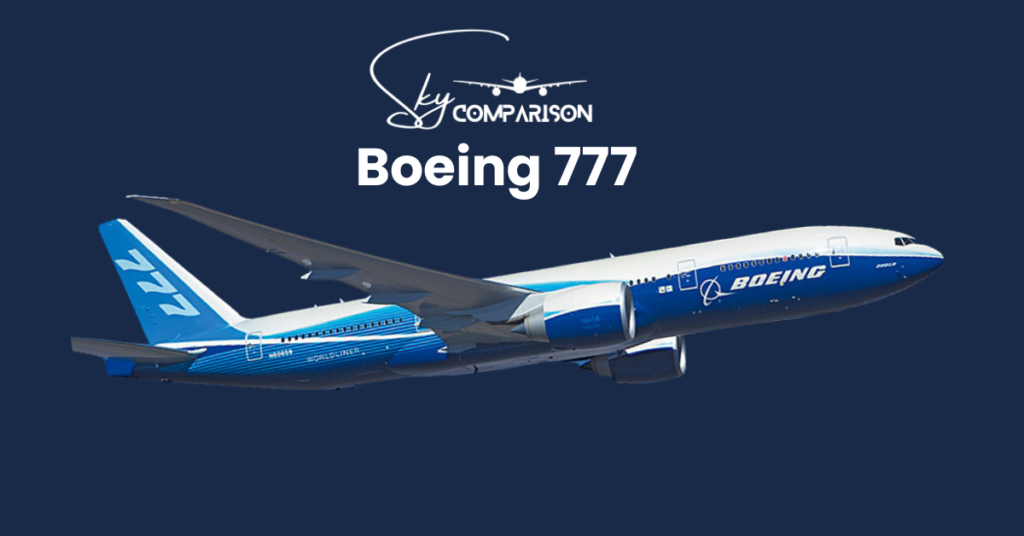
The Boeing 777, which first took to the skies in the mid-1990s, is like a superstar of the airplane world. It’s known for being really big, able to fly very far, and packed with cool technology. This makes it perfect for long trips that cross oceans or connect distant countries. What’s exciting is Boeing didn’t stop there; they came up with the 777X series, including the 777-9. This new plane is going to be the longest one flying, stretching further than any other airliner you’ve seen. Boeing is always looking to be better, making planes that can carry more people further, but using less fuel.
Boeing 767 vs 777 Engines
When we compare the engines of the Boeing 767 and the 777, we’re looking at two different generations of technology and performance. The 767 and 777 are both twin-engine jets, but the types of engines they use, and the power they deliver, vary significantly because of the advancements in engine technology and the different needs of the aircraft. The engines on the 777 not only produce more power but are also designed to be more fuel-efficient and quieter, reflecting advancements in engine technology and environmental considerations. This increase in efficiency and power allows the 777 to fly longer routes with more passengers and cargo, making it a workhorse for international long-haul flights.
The difference in engine technology also means the 777 can take advantage of newer developments like higher bypass ratios and composite materials, which contribute to its engines being more efficient and capable of delivering higher thrust. These improvements are part of why the 777 can operate longer flights and carry more weight, meeting the demands of airlines for more efficient and cost-effective operations.
Boeing 767 Engines
The Boeing 767 uses engines from the earlier generation. Depending on the model of the 767, it might be equipped with engines from General Electric, Rolls-Royce, or Pratt & Whitney. These engines are designed to be efficient and reliable for the medium to long-haul flights that the 767 typically operates. They offer a balance of fuel efficiency and power, suitable for the aircraft’s size and the routes it serves.
Boeing 777 Engines
The Boeing 777, being a larger and newer aircraft, requires more powerful engines. It was the first commercial airliner to be designed entirely with computer-aided design (CAD) technologies, and its engines reflect the latest in aviation technology. The 777 can be equipped with engines from the same manufacturers—General Electric, Rolls-Royce, or Pratt & Whitney—but these engines are larger, more powerful, and incorporate more advanced technology than those used on the 767. For example, the GE90 engine1 used on many 777 models is one of the most powerful jet engines in the world, capable of producing a tremendous amount of thrust to carry more passengers over longer distances.
Boeing 767 vs 777 Dimensions
The Boeing 767 vs 777 are two of Boeing’s most popular wide-body aircraft, serving different market segments with their unique capabilities. The 777-200ER outshines the 767-300ER in terms of length, wingspan, wing area, and height, indicating its larger size and capacity to carry more passengers over longer distances. With more powerful engines, the 777-200ER also boasts a higher total thrust, enabling a greater maximum takeoff weight (MTOW) and extended range. The cruise speed of the 777-200ER is slightly higher, further enhancing its efficiency on long-haul routes. While the 767-300ER is a capable aircraft for medium to long-haul flights with a respectable passenger capacity, the 777-200ER is designed for airlines needing higher capacity and longer range, making it a versatile choice for global operations.
| Specification | Boeing 767-300ER | Boeing 777-200ER |
|---|---|---|
| Length | 54.90 m / 180 ft 1 in | 63.70 m / 209 ft |
| Wingspan | 47.60 m / 156 ft 2 in | 60.90 m / 199 ft 10 in |
| Wing Area | 283.30 m² / 3,049 ft² | 427.80 m² / 4,605 ft² |
| Height | 15.80 m / 51 ft 10 in | 18.50 m / 60 ft 8 in |
| Engines | 2 | 2 |
| Thrust per Engine | 282 kN / 63,300 lbf | 417 kN / 93,700 lbf |
| Total Thrust | 564 kN / 126,600 lbf | 834 kN / 187,400 lbf |
| MTOW | 186,680 kgs / 412,000 lbs | 297,560 kgs / 656,000 lbs |
| Range | 11,300 km / 6,102 nm | 14,316 km / 7,731 nm |
| Cruise Speed | M0.8 | M0.84 |
| Passenger Capacity | 218 | 301 |
Boeing 767 vs 777 Seating Capacity
When comparing the seating capacities of the Boeing 767 vs 777, it’s like looking at two siblings with different strengths. The 767 is the smaller of the two, offering a cozy setup that can vary from 174 seats in a luxurious three-class configuration to up to 409 seats when arranged in a single-class layout across its different versions. This range shows the 767’s versatility, adapting to different airline needs whether for more comfort or packing in passengers. The most common setup you’ll find, especially with airlines like Delta, places around 218 to 242 seats in planes with three classes, blending comfort with capacity.
Boeing 777 Seating Capacity
On the other hand, the Boeing 777 is like the big brother, designed for more passengers and longer hauls. It stretches its legs with seating that ranges from 234 to 426 passengers across various cabin layouts and airline preferences. This plane shines on long international flights where airlines use two, three, or even four-class configurations to meet diverse passenger needs. For instance, in a three-class setup, airlines can accommodate between 309 and 350 travelers, showcasing the 777’s ability to carry more people across the skies comfortably.
Boeing 767 Seating Capacity
In essence, while the 767 offers a more intimate flying experience suitable for medium to long distances with a flexible seating arrangement, the 777 takes the crown for sheer passenger volume, making it the go-to for bustling long-haul routes. Both planes offer configurations that emphasize comfort, with the 767 commonly using a 2-3-2 layout in economy for easier aisle access, and the 777 often opting for a 3-4-3 or 3-3-3 arrangement, pushing the boundaries of space and efficiency on longer flights.
Boeing 767 vs 777 Customers and Orders
The Boeing 767 vs 777 are two of Boeing’s most iconic aircraft, each serving different needs in the aviation industry. As of the end of April 2023, the 767 had seen 1,273 deliveries across its various models, with the 767-300ER being the most popular variant, making up 46% of all 767 deliveries. There were also 117 unfulfilled orders for the 767 at that time, primarily for the cargo versions, highlighting its continued demand in the cargo sector. The 777, on the other hand, had a total of 1,706 deliveries, with the 777-300ER variant being the standout, accounting for 49% of all 777 deliveries.
| Aspect | Boeing 767 | Boeing 777 |
|---|---|---|
| Total Deliveries | 1,273 | 1,706 |
| Most Popular Variant | 767-300ER | 777-300ER |
| % of Deliveries by Popular Variant | 46% | 49% |
| Unfulfilled Orders | 117 | 436 |
| Total (Deliveries + Orders) | 1,390 | 2,142 |
The 777 also had a significant number of unfulfilled orders, totaling 436, with a large portion being for the next-generation 777-X models. This shows a strong ongoing demand for the 777, particularly for its newer variants. While both the 767 and 777 have been pivotal to Boeing’s success, the 777 appears to be leading in terms of popularity and future orders, especially with the introduction of the 777-X, indicating its continued relevance in both passenger and cargo aviation markets.
Conclusion
In summary, the Boeing 767 vs 777 serve distinct yet crucial roles in aviation. The 767 is ideal for medium-haul efficiency, while the 777 excels in long-haul capacity and technology. Their differences reflect Boeing’s adaptation to diverse market needs, showcasing the company’s commitment to innovation. Choosing between them depends on route specifics, demand, and operational goals, underscoring each aircraft’s unique contribution to global air travel.
FaQs
What are the main differences between the Boeing 767 vs 777?
The main differences lie in their size, range, and technology. The 767 is smaller, designed for medium-haul flights, and typically seats between 181 to 375 passengers. The 777, on the other hand, is larger, built for long-haul flights, and can accommodate 301 to 396 passengers, depending on the variant.
Can the Boeing 767 and 777 be used interchangeably?
While both can serve overlapping roles, they are not fully interchangeable. The 767 is better suited for routes with lower demand or shorter distances, whereas the 777 is designed for high-demand, long-distance routes.
Which aircraft is more fuel-efficient?
The Boeing 767 is generally more fuel-efficient on shorter, medium-haul routes due to its smaller size. However, the 777 offers better fuel efficiency per passenger on longer, intercontinental flights due to its advanced engines and aerodynamics.

